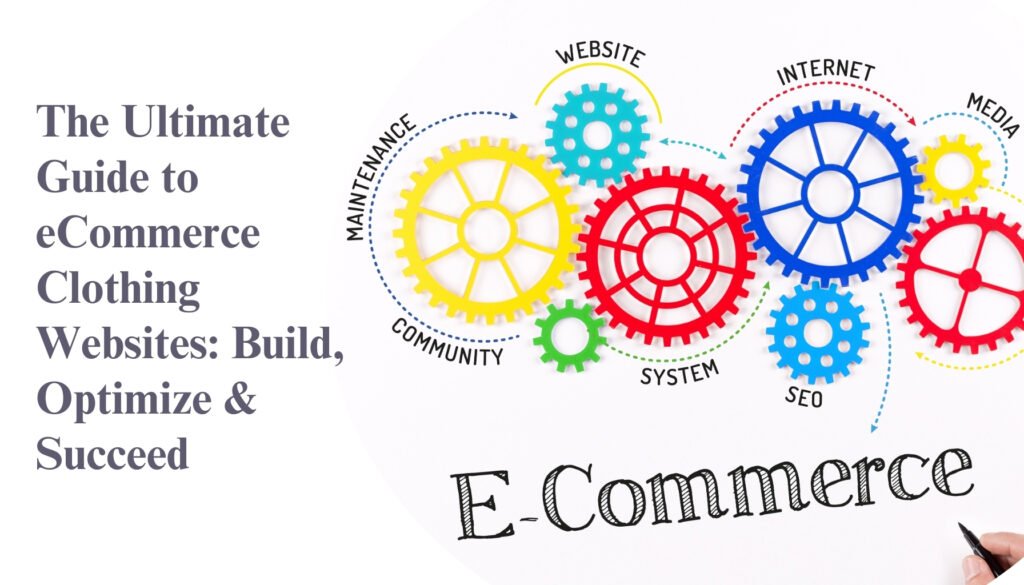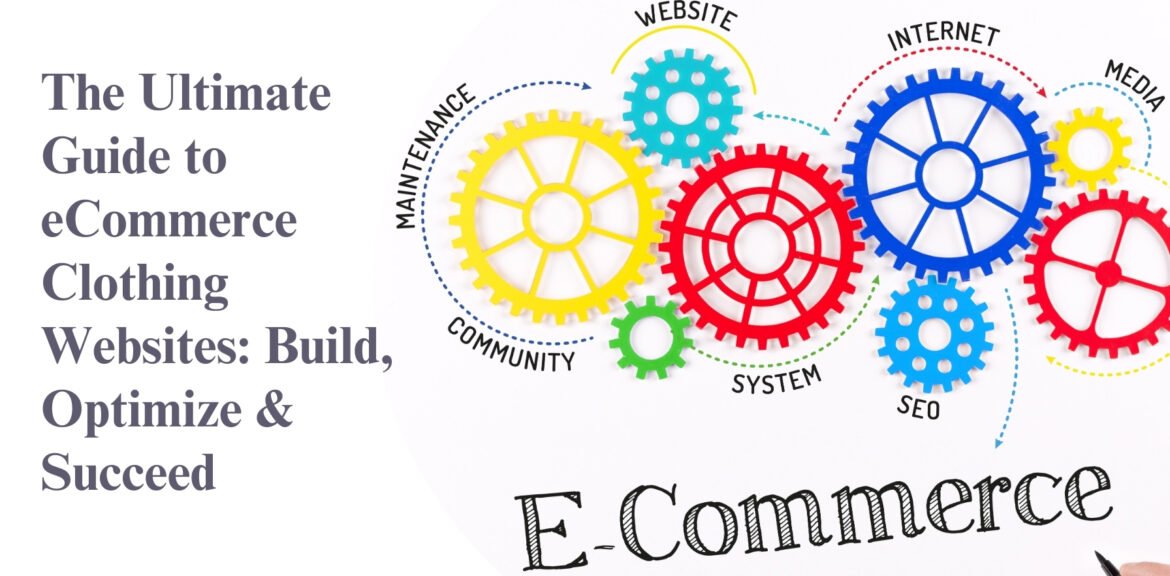In today’s fast-paced digital world, having a eCommerce clothing website is no longer a luxury—it’s a necessity. The fashion industry is one of the most competitive markets, and having a well-optimized, visually appealing, and user-friendly website can make all the difference.
This comprehensive guide will walk you through everything you need to know about eCommerce clothing websites, from setting up your store to optimizing it for maximum conversions and visibility.

Why You Need an eCommerce Clothing Website
In today’s digital era, fashion brands, retailers, and independent designers need an eCommerce clothing website to stay competitive. Consumers increasingly prefer online shopping due to its convenience, variety, and accessibility. An eCommerce clothing website allows businesses to reach a broader audience, operate with lower costs, and provide a seamless shopping experience. Below, we’ll dive deeper into why having an online clothing store is essential.
1. Reach a Global Audience
A physical clothing store is limited by geography—you can only serve customers who visit your store. However, with an eCommerce clothing website, your brand can sell to customers nationwide or even globally. This means:
- You’re not restricted by location, allowing international expansion.
- Customers from different time zones can shop at their convenience.
- You can target specific regions with tailored marketing strategies.
- With the right shipping options, you can deliver to almost any part of the world.
For example, major brands like Zara and H&M use their eCommerce clothing websites to tap into markets beyond their physical locations.
2. Lower Operational Costs
Compared to a brick-and-mortar store, an eCommerce clothing website significantly reduces operational expenses. Some cost-saving benefits include:
- No Rent or Utilities: Physical stores require rent, electricity, water, and other maintenance expenses.
- Fewer Staff Required: While a retail store needs multiple employees, an eCommerce store can run with a small team.
- Automated Order Management: Online stores integrate inventory management software, reducing the need for manual stock-taking.
- Lower Marketing Costs: Online advertising (social media, SEO, email marketing) is more affordable and effective than traditional print ads or TV commercials.
These factors allow small fashion brands and startups to compete with larger retailers without massive financial investments.
3. 24/7 Availability
One of the biggest advantages of an eCommerce clothing website is that it’s always open. Unlike a traditional store that follows strict hours, an online store operates 24/7, providing:
- Convenience for customers: Shoppers can browse and buy at any time—whether early morning or midnight.
- Increased revenue potential: More shopping hours mean more opportunities for sales.
- Reduced dependency on staff: Your store continues running even without employees actively working.
Imagine a customer looking for a dress at 2 AM—with an eCommerce clothing website, they can place an order instantly instead of waiting for a store to open the next day.

4. Enhanced Customer Engagement
An eCommerce clothing website offers unique ways to engage with customers, making shopping an interactive experience. Some engagement features include:
- Live Chat & Chatbots: Answer customer queries instantly, improving satisfaction.
- Social Media Integration: Let users share their favorite outfits and reviews directly on platforms like Instagram, Facebook, and TikTok.
- Personalized Recommendations: AI-driven suggestions based on customer preferences boost sales.
- User Reviews & Ratings: Build credibility by showcasing customer feedback.
- Loyalty Programs: Offer discounts and rewards to encourage repeat purchases.
A well-optimized eCommerce clothing website makes customers feel connected to your brand, leading to higher retention rates and word-of-mouth marketing.
5. Data-Driven Decision Making
Unlike physical stores, an eCommerce clothing website allows businesses to collect detailed customer data, helping brands optimize their strategies. Some insights include:
- Popular products & categories: Identify bestsellers and optimize stock levels.
- Customer behavior: Track how visitors interact with the site, allowing for UI/UX improvements.
- Sales trends: Spot seasonal trends and adjust promotions accordingly.
- Marketing effectiveness: Analyze which campaigns drive the most traffic and conversions.
With Google Analytics, Facebook Pixel, and other tracking tools, brands can make data-backed decisions to grow their online clothing business.
6. Scalability & Flexibility
An eCommerce clothing website can quickly scale based on demand. Whether you’re expanding to new product lines or increasing your marketing efforts, online stores offer flexibility, such as:
- Easy product updates: Add new styles, collections, or seasonal sales instantly.
- Multiple payment options: Accept credit cards, PayPal, Apple Pay, and even cryptocurrencies.
- Omnichannel Selling: Sell not just on your website but also on Amazon, Etsy, and social media platforms.
- Dropshipping Opportunities: Partner with suppliers to sell products without holding inventory.
With these advantages, your eCommerce clothing website can scale up without major investments.
7. Competitive Edge in the Fashion Industry
Fashion is a highly competitive industry, but having an eCommerce clothing website gives brands an edge over traditional retailers. With the right digital marketing strategies, businesses can:
- Rank higher on Google search results through SEO-optimized product pages.
- Utilize email marketing to send personalized offers.
- Leverage influencer collaborations to boost credibility and sales.
- Use retargeting ads to bring back visitors who didn’t complete their purchases.
Fashion brands that embrace eCommerce not only survive but thrive in an evolving digital landscape.
Key Features of a High-Performing eCommerce Clothing Website
A successful eCommerce clothing website must include:
1. User-Friendly Design
A clean, responsive, and easy-to-navigate website enhances user experience and boosts conversions.
2. High-Quality Product Images
Professional, high-resolution images with zoom-in capabilities help customers make informed purchasing decisions.
3. Secure Payment Gateways
Offering multiple secure payment options, including credit cards, PayPal, and digital wallets, builds customer trust.
4. Mobile Optimization
A mobile-responsive eCommerce clothing website ensures a seamless shopping experience across all devices.
5. SEO Optimization
Incorporating relevant keywords, meta descriptions, and high-quality content helps rank your website higher on search engines.
6. Customer Reviews & Testimonials
Displaying user reviews and ratings boosts credibility and influences purchasing decisions.

Steps to Create an eCommerce Clothing Website
Creating an eCommerce clothing website involves strategic planning, design, and execution to ensure success. Below, we provide a step-by-step guide to help you build a high-performing online fashion store.
1. Choose the Right eCommerce Platform
The first step in building an eCommerce clothing website is selecting a reliable platform that fits your business needs. Some of the most popular eCommerce platforms include:
Shopify
- Best for beginners due to its user-friendly interface.
- Provides ready-made templates and easy customization.
- Offers integrated payment gateways like PayPal and Stripe.
- Supports dropshipping if you don’t want to hold inventory.
WooCommerce (WordPress)
- A flexible open-source platform.
- Ideal if you already have a WordPress website.
- Offers extensive plugins and customization options.
- Requires manual hosting setup but gives more control.
Magento
- Best for large-scale businesses.
- Offers advanced security features and customization.
- Requires technical expertise for setup and maintenance.
- Scalable for enterprises with high traffic.
Each platform has its pros and cons, so choose based on your budget, business size, and technical expertise.
2. Select a Domain Name
Your domain name is your digital identity. A well-chosen domain can help with branding and SEO. Consider the following tips when picking a domain for your eCommerce clothing website:
Keep it short and memorable (e.g., FashionTrend.com).
Use keywords related to fashion (e.g., StylishWear.com).
Avoid numbers and hyphens, as they make domains harder to remember.
Choose a .com extension, as it’s the most trusted by users.
Once you have a domain name, register it using services like GoDaddy, Namecheap, or Google Domains.
3. Design Your Website
A visually appealing eCommerce clothing website enhances user experience and boosts conversions. Focus on the following:
User-Friendly Layout
- Use clean, minimalistic designs with easy navigation.
- Implement a search bar and category filters for smooth browsing.
- Ensure quick-loading pages for an optimal user experience.
Mobile Responsiveness
- Over 60% of online shopping happens on mobile devices.
- Your website should adapt seamlessly to different screen sizes.
Brand Identity
- Choose colors, fonts, and graphics that match your brand’s aesthetics.
- Use professional branding elements like a logo and tagline.
A well-designed eCommerce clothing website increases customer trust and engagement, leading to higher conversions.
4. Add High-Quality Product Listings
Product presentation is key to driving sales on an eCommerce clothing website. Follow these tips:
Use High-Resolution Images
- Showcase multiple angles of each product.
- Use zoom-in features for better details.
- Include models wearing the clothes to help customers visualize.
Write Compelling Product Descriptions
- Mention material, sizing, colors, and special features.
- Use engaging, brand-appropriate language.
- Optimize with relevant keywords for SEO.
Include Clear Pricing & Availability
- Display pricing upfront to avoid confusion.
- Indicate if items are limited edition or low in stock.
Product pages on an eCommerce clothing website should convince customers to buy while providing them with all necessary details.
5. Set Up Payment and Shipping Methods
Customers expect secure and flexible payment options when shopping on an eCommerce clothing website.
Offer Multiple Payment Methods
- Credit/Debit Cards (Visa, Mastercard, Amex)
- PayPal, Apple Pay, Google Pay
- Buy Now, Pay Later (Klarna, Afterpay)
Provide Flexible Shipping Options
- Standard & Express Shipping options
- Free Shipping for orders above a certain amount
- International Delivery if targeting global customers
A seamless checkout process reduces cart abandonment rates, increasing sales.
6. Optimize for SEO
To attract organic traffic, an eCommerce clothing website must be optimized for search engines. Key SEO tactics include:
Keyword Optimization
- Use relevant keywords (e.g., “affordable women’s dresses,” “men’s casual wear”) in titles, descriptions, and product pages.
Page Speed Optimization
- Optimize images, use caching, and choose fast hosting to improve loading times.
Meta Tags & URLs
- Create SEO-friendly URLs (e.g., “yourstore.com/mens-tshirts” instead of “yourstore.com/p12345”).
- Write engaging meta descriptions to improve click-through rates.
A well-optimized eCommerce clothing website ranks higher in Google search results, attracting more customers.
7. Market Your Website
Once your eCommerce clothing website is live, use digital marketing strategies to drive traffic and increase sales.
Social Media Marketing
- Use Instagram, Facebook, TikTok, and Pinterest to showcase products.
- Post high-quality visuals, reels, and user-generated content.
- Run targeted ads to reach potential customers.
Influencer Collaborations
- Partner with fashion bloggers and Instagram influencers to promote your brand.
- Influencers provide authentic reviews and styling ideas, attracting new buyers.
Email Marketing
- Send personalized emails with exclusive discounts, product recommendations, and styling tips.
- Implement cart abandonment emails to recover lost sales.
SEO and Content Marketing
- Publish fashion blogs, trend reports, and style guides to attract organic visitors.
- Optimize content with search-friendly keywords to rank higher.
Paid Advertising
- Use Google Ads and Facebook Ads to drive targeted traffic.
- Invest in retargeting ads to reach visitors who didn’t complete purchases.
With the right marketing strategy, your eCommerce clothing website can grow rapidly, increasing revenue and brand recognition.
Common Challenges and Solutions in eCommerce Clothing Websites
Running an eCommerce clothing website can be highly profitable, but it comes with its own set of challenges. To succeed in the competitive online fashion market, businesses must identify these obstacles and implement effective solutions. Below, we dive into the most common challenges and how to overcome them.
1. High Cart Abandonment Rates
The Problem:
Cart abandonment happens when customers add products to their cart but leave without completing the purchase. Studies show that the average cart abandonment rate is over 70% in the eCommerce industry.
Why It Happens:
- Unexpected shipping costs or taxes.
- Complex or lengthy checkout process.
- Limited payment options.
- Concerns about security.
- Customers browsing but not ready to buy.
The Solution:
1. Offer Incentives to Complete the Purchase
- Provide free shipping or discounts on first orders.
- Display limited-time offers (e.g., “10% off for the next 30 minutes”).
- Use exit-intent popups to capture customers before they leave.
2. Simplify the Checkout Process
- Enable one-page checkout to reduce steps.
- Offer a guest checkout option (many customers abandon carts when forced to create an account).
- Use auto-fill and multiple payment options (credit cards, PayPal, Apple Pay, Klarna).
3. Implement Cart Abandonment Emails
- Send personalized reminders to customers with their cart items.
- Include special offers or urgency-based messages (e.g., “Your cart is expiring soon!”).
By making checkout fast, seamless, and rewarding, an eCommerce clothing website can recover lost sales and increase conversions.
Low Conversion Rates
The Problem:
Many visitors browse an eCommerce clothing website but leave without making a purchase. This results in a low conversion rate, meaning fewer sales despite high website traffic.
Why It Happens:
- Unclear product descriptions or missing information.
- Poor-quality images that don’t showcase the clothing properly.
- Slow website speed, causing frustration.
- Lack of customer reviews and trust signals.
The Solution:
1. Improve Product Pages for Better Engagement
- Use detailed, engaging descriptions with fabric details, sizing guides, and styling tips.
- Add high-resolution images with zoom functionality and multiple angles.
- Include videos of models wearing the clothing to give customers a better idea of fit and style.
2. Optimize Website Speed
- Compress images without sacrificing quality to reduce loading time.
- Use a fast hosting provider to prevent website slowdowns.
- Enable lazy loading so images load only when needed.
3. Display Social Proof
- Add customer reviews and star ratings to build trust.
- Show user-generated content (customers posting pictures of themselves wearing your clothing).
- Display security badges (e.g., SSL certificates) to assure shoppers that transactions are safe.
By enhancing product pages, optimizing speed, and building trust, you can turn more visitors into paying customers.
3. Intense Competition in the Fashion Industry
The Problem:
The online fashion industry is highly saturated, making it difficult for new brands to stand out. With major brands and fast-fashion retailers dominating the market, smaller businesses often struggle to gain visibility and attract customers.
Why It Happens:
- Many stores sell similar products, making differentiation difficult.
- Big brands invest heavily in marketing, pushing smaller stores down in search rankings.
- Customers trust established brands over new ones.
The Solution:
1. Differentiate Your Brand with Unique Designs & Storytelling
- Focus on a niche market (e.g., eco-friendly fashion, plus-size fashion, luxury streetwear).
- Develop a strong brand identity with a compelling backstory.
- Use sustainable materials or ethical production to appeal to conscious consumers.
2. Provide Exceptional Customer Service
- Offer live chat support to assist shoppers in real-time.
- Implement a hassle-free return and exchange policy.
- Personalize customer interactions by using AI-driven recommendations and personalized emails.
3. Leverage Influencer & Community Marketing
- Partner with fashion influencers to promote your brand.
- Encourage customers to share user-generated content (e.g., Instagram posts wearing your products).
- Create a loyalty program that rewards repeat customers.
By focusing on brand uniqueness, customer service, and influencer collaborations, an eCommerce clothing website can gain a competitive edge in the market.
People Also Ask
| Question | Answer |
|---|---|
| What platform is best for an eCommerce clothing website? | Shopify, WooCommerce, and Magento are popular choices. |
| How much does it cost to build an eCommerce clothing website? | Costs vary but typically range from $500 to $10,000, depending on customization and features. |
| How can I drive traffic to my eCommerce clothing website? | Utilize SEO, social media, email marketing, and paid ads. |
| What are the must-have features of an eCommerce clothing website? | Mobile responsiveness, secure payments, high-quality images, and SEO optimization. |
FAQs
1. What is an eCommerce clothing website?
An eCommerce clothing website is an online platform that allows businesses to sell fashion products to customers worldwide.
2. How can I make my eCommerce clothing website stand out?
Focus on branding, offer unique products, provide excellent customer service, and implement strong marketing strategies.
3. How do I increase sales on my eCommerce clothing website?
Use SEO, run promotions, engage customers on social media, and offer a seamless shopping experience.
4. What is the best payment gateway for an eCommerce clothing website?
Popular choices include PayPal, Stripe, and Square, offering secure and fast transactions.
5. How do I optimize my eCommerce clothing website for SEO?
Use relevant keywords, create high-quality content, and ensure fast website loading speeds.
Conclusion
Building a successful eCommerce clothing website requires the right strategy, platform, and marketing techniques. Whether you are launching a new brand or optimizing an existing store, focusing on user experience, SEO, and effective marketing will help you achieve long-term success.
For professional eCommerce clothing website development and digital marketing solutions, visit Wisdom Digital Marketing and explore our website development services to take your online store to the next level.















